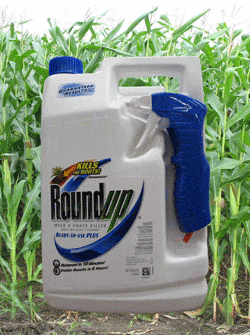GreenMedInfo
by Sayer Ji
The GM farming system has made exposure to Roundup herbicide a daily fact of our existence, and according to the latest US Geological Survey study its probably in the air you are breathing…
 A new study from the U.S. Geological Survey, accepted for publication online ahead of print in the journal Enviromental Toxicology and Chemistry, titled, “Pesticides in Mississippi air and rain: A comparison between 1995 and 2007,”[i] reveals that Roundup herbicide (aka glyphosate) and its still-toxic degradation byproduct AMPA were found in over 75% of the air and rain samples tested from Mississippi in 2007.
A new study from the U.S. Geological Survey, accepted for publication online ahead of print in the journal Enviromental Toxicology and Chemistry, titled, “Pesticides in Mississippi air and rain: A comparison between 1995 and 2007,”[i] reveals that Roundup herbicide (aka glyphosate) and its still-toxic degradation byproduct AMPA were found in over 75% of the air and rain samples tested from Mississippi in 2007.
The researchers evaluated a wide range of pesticides currently being used through weekly composite air and rain sampling collected during the 1995 and 2007 growing seasons in the Mississippi Delta agricultural region.
The researchers discovered the following:
- Thirty-seven compounds were detected in the air or rain samples in 2007; 20 of these were present in both air and rain.
- Glyphosate was the predominant new herbicide detected in both air (86%) and rain (77%) in 2007, but were not measured in 1995.
- Decreased overall pesticide use in 2007 relative to 1995 generally resulted in decreased detection frequencies in air and rain, but observed concentration ranges were similar between years even though the 1995 sampling site was 500 m from active fields while the 2007 sampling site was within 3 m of a field.
- Mean concentration of detections were sometimes greater in 2007 than in 1995 but the median values were often lower.
- Seven compounds in 1995 and five in 2007 were detected in ≥50% of both air and rain samples. Atrazine, metolachlor, and propanil were detected in ≥50% of the air and rain samples in both years.
- Total herbicide flux in 2007 was slightly greater than in 1995, and was dominated by glyphosate.
According to the report, 2 million kilograms of glyphosate were applied statewide in 2007, or 55% of the total herbicide flux for that year (~129 μg/m2), leading them to state the high prevalence of glyphosate in air and water “was not surprising.” Even though glyphosate was only tested in 2007, based on the 1995 figures on glyphosate use (147,000 kg state-wide) the researchers estimated that glyphosate added 3% of the total herbicide flux for 1995, or approximately 7 micrograms per centimeter (~7 μg/m2) per sample. This estimate, if correct, reveals that there has been an ~ 18 fold increase in glyphosate concentrations in air and water samples in only 12 years (1995-2007).
The researchers pointed out that, “the 2007 weekly air concentration pattern for glyphosate was similar to those of other commonly detected herbicides in both 1995 and 2007 in that the highest concentrations occurred in April and May. However, there were detectable concentrations of glyphosate over the entire growing season, which is consistent with how glyphosate is used on GM crops, including for post-emergent weed control throughout the growing season.” The longer period of exposure adds to growing concern that this ubiquitous toxicant represents an unavoidable body burden and that even small daily environmental exposures may be causing significant harm through their cumulative and synergistic effects with other toxicants.
So, what is the toxicological significance of the discovery of glyphosate in most air samples tested? In the month of August, 2007, if you were breathing in the sampled air you would be inhaling approximately 2.5 nanograms of glyphosate per cubic meter of air. It has been estimated the average adult inhales approximately 388 cubic feet or 11 cubic meters of air per day, which would equal to 27.5 nanograms (billionths of a gram) of glyphosate a day. Of course, when one considers the presence of dozens of other agrichemicals found alongside glyphosate in these samples, the interactions between them are incalculably complex and produce far more harm together than glyphosate alone (i.e. synergistic toxicity). Also, now that recent cell research has shown that glyphosate may act as an endocrine disrupter exhibiting estrogenic-like carcinogenicity within the part-per-trillion range, there is all the more reason to raise the red flag of the precautionary principle — especially since inhaled toxicants evade the elaborate detoxification mechanisms of ingested toxicants which must pass through the microbiome, intestinal lining and liver before entering the blood and only a long time later the lung far downstream.
This study brings to the surface the extent to which GM farming has altered our daily exposure to chemicals, such that even the rain and air we now breath contains physiologically relevant levels of glyphosate ‘fall out’ from the war against any plant not part of the monocultured, genetically engineered system of production. With a significant body of research now available today showing that glyphosate and its components are far more toxic than believed at the time of its widespread approval, the implications of ubiquitous glyphosate exposure should be carefully considered.
Ultimately, findings like these reveal just how illusory is the perception of choice and health freedom when it comes to the GM/non-GMO debate, and the consumer’s right to avoid harm from GMOs by refusing to buy or consume them. Not only are consumers in the U.S. not allowed to know what is in their food with accurate and truthful labeling of ingredients, we now know that biopollution from GMOs produces uncontrollable and irreversible changes in the genomes of affected organisms when their transgenes escape into them, and we know that even beyond their genomic/proteomic differences the contamination of GM foods with herbicides like Roundup (glyphosate) makes them non-substantially equivalent in chemical composition to their non-contaminated alternatives. The reality is that the environment is becoming so saturated with the ‘fall out’ from the ever-expanding GM agricultural/agrichemical farming grid that even if you somehow find a way to avoid eating contaminated food, you will be forced to have to deal with its adverse health effects, as long as you need air to breath and water to drink. Ultimately, unless our food production system moves through its present chemical war-modeled phase of GM monoculturing, even non-GM food will end up being contaminated with these chemicals and transgenes, because nothing ‘natural’ lives in a vacuum – and if it does, then it really shouldn’t be called “organic,” and maybe shouldn’t even be called food.
[i] Michael S Majewski, Richard H Coupe, William T Foreman, Paul D Capel. Pesticides in Mississippi air and rain: A comparison between 1995 and 2007. Environ Toxicol Chem. 2014 Feb 19. Epub 2014 Feb 19. PMID: 24549493

